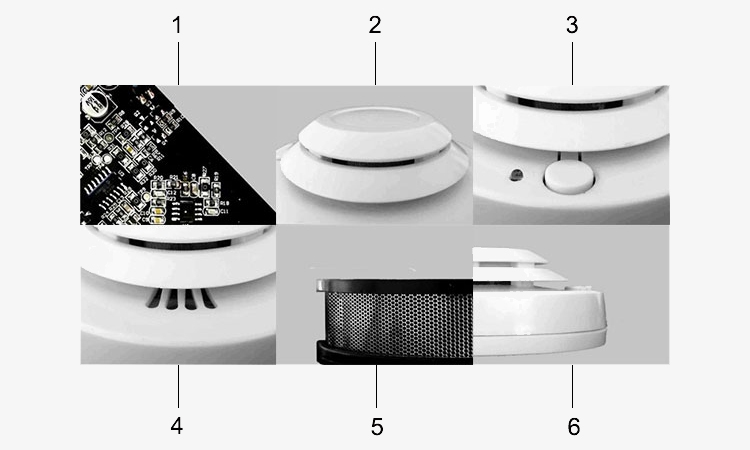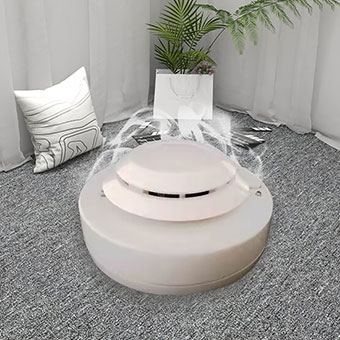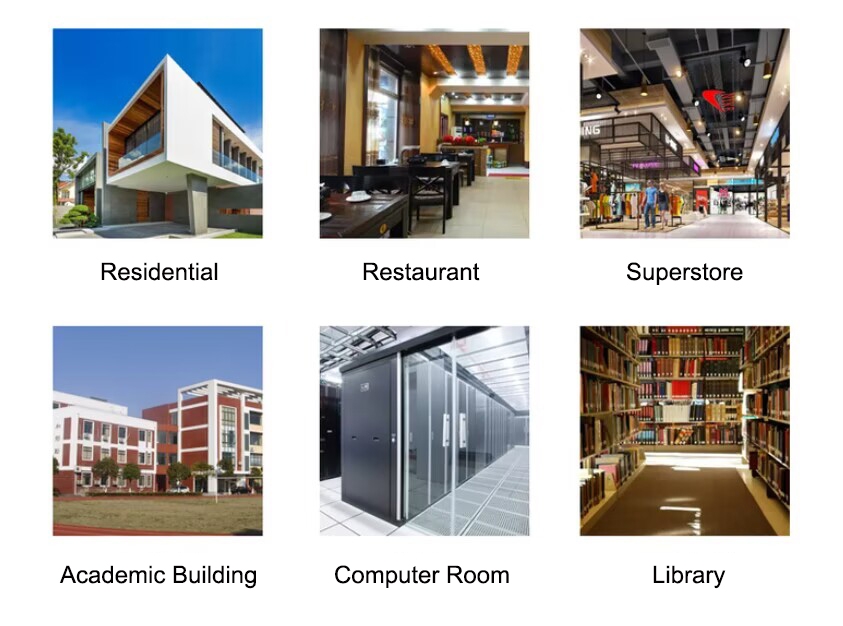The wall-mountable photoelectric smoke detector can accurately determine whether the smoke concentration in the environment exceeds the standard and quickly alarm, with a standby current of 10uA, detecting smoke covering an area of 60m2 to 80m2, it is an excellent smoke alarm for preventing accidental fires and stopping the spread of the disaster.

Photoelectric smoke detector, wall mounted, smoke alarms details
- FR-4 fiberglass circuit board, sound and heat insulation quality is better and more excellent
- Gas detection holes for quick perception of ambient smoke.
- Test button and indicator light, working status at any time to know
- Buzzer sound port, smooth and louder sound transmission
- Safe cover design, dust-proof, insect-proof and white light-proof.
- ABS flame retardant material, safe and more environmentally friendly

Photoelectric smoke detector, wall mounted, smoke alarms features
- MCU Handling
- Automatic reset
- Test button
- Infrared photoelectric sensor
- Network Output/LED Indicator
- EMI resistant stainless steel shielding
- Adoption of SMT
- Strong adaptability to the environment dustproof, mothproof, anti-white light
Applications
sisco photoelectric smoke detectors are used in a wide range of applications, such as residences, hotels, superstores, school buildings, computer rooms, libraries , ect.

| Model | SISCO-BJR-3 |
| Standby Current | 10uA |
| Power Supply | 9V 6F22 Battery |
| Alarm Current | 10mA |
| Sensor | Infrared Photoelectric Sensor |
| Sensitivity | 2.06%ft±1.3%ft (ft, unit of length) |
| Static Current | ≤10 (uA) |
| Alarm Output | N/A |
| Alarm Mode | Audible and visual alarm |
| Sound Level | 85dB/1M |
| Installation | Ceiling Installation |
| Working Environment | -10~+50 (℃),≤95%RH (relative humidity) |
| Dimension | 115*47mm |
| Net Weight | 460g |
Q1: What is a photoelectric smoke detector?
A1: A photoelectric smoke detector is a device used for fire safety that monitors smoke in the air through optical and electronic technology. It consists of a light source and a photosensor, which shines into the air, and when smoke particles enter the detection area, they scatter light and are captured by the photosensor. Once smoke is detected, the smoke detector triggers an alarm to notify people of the presence of a fire so that early action can be taken and the police can be alerted. This technology is widely used in residential, commercial, and industrial buildings to help improve fire safety.
Q2: How do photoelectric smoke detectors work?
A2: The photoelectric smoke alarm detects smoke in two main ways. First, it contains an emitter and a receiver. The transmitter emits a steady beam of light, usually infrared. The receiver can receive the beam if there is no smoke interference. However, when smoke enters the detector's sensing area, the smoke particles scatter the beam, preventing the receiver from picking up enough of the light signal. This change is recognized by the detector as smoke, triggering an alarm. This principle of operation allows photoelectric smoke detectors to quickly and sensitively detect fires and provide early warning.
Q3: What are the types of photoelectric smoke detector?
A3: Photoelectric smoke detectors are a type of safety device used to detect smoke, and common types include the following.
Light Scattering: Detects the presence of smoke particles by scattering light, triggering an alarm when smoke obstructs the light.
Light Absorption: Detects smoke by measuring how much light is absorbed by the smoke, usually using an infrared or ultraviolet light source.
Spectral Analysis: Uses a multi-wavelength light source and spectral analysis technology to distinguish between different types of smoke and reduce false alarms.
Photoionization Type: Using photoelectric effect to detect ions or molecules in smoke, sensitive to early detection of fire.
Photoelectric Heat-sensitive Type: Combines light scattering and heat-sensitive elements to improve the accuracy and reliability of smoke detectors.
Tips: Photoelectric smoke detector installation method and note
Installation Method:
Select the Mounting Location: Mount in the center of the ceiling, away from direct sunlight and air circulation.
Use screws and brackets to secure the detector in the chosen location.
Connect Power: Connect the wire to the power source to ensure a stable power supply.
Conduct a Test: After the installation is complete, conduct a smoke test to ensure proper operation.
Regular Maintenance: Clean and inspect regularly to ensure the detector is in good condition.
Note:
Make sure the detector installation is done by a professional.
Avoid installation in wet, dusty, or temperature-extreme environments.
Do not cover or obscure the detector as this may affect normal operation.
Test the detector periodically to ensure its reliability.
Follow the manufacturer's installation and maintenance guidelines to ensure safety and effectiveness.
Thank you for buying industrial test and measurement equipment on sisco.com, all products sold by sisco and the partner cover a 12 months warranty, effective from the date of receiving the products.
What is covered?
sisco is responsible for providing free spare parts, and free technical support to assist the customer to repair the defective products until the problem is solved.
What is not covered?
- Product purchased from anyone other than a sisco store or a sisco authorized reseller.
- Expendable parts.
- Routine cleaning or normal cosmetic and mechanical wear.
- Damage from misuse, abuse or neglect.
- Damage from use of parts other than sisco approved.
- Damage from use outside the product’s usage or storage parameters.
- Damage from use of parts not sold by sisco.
- Damage from modification or incorporation into other products.
- Damage from repair or replacement of warranted parts by a service provider other than a sisco authorized service provider.
- Damage caused by the application environment not meeting the product usage requirements and the failure to perform preventive maintenance.

